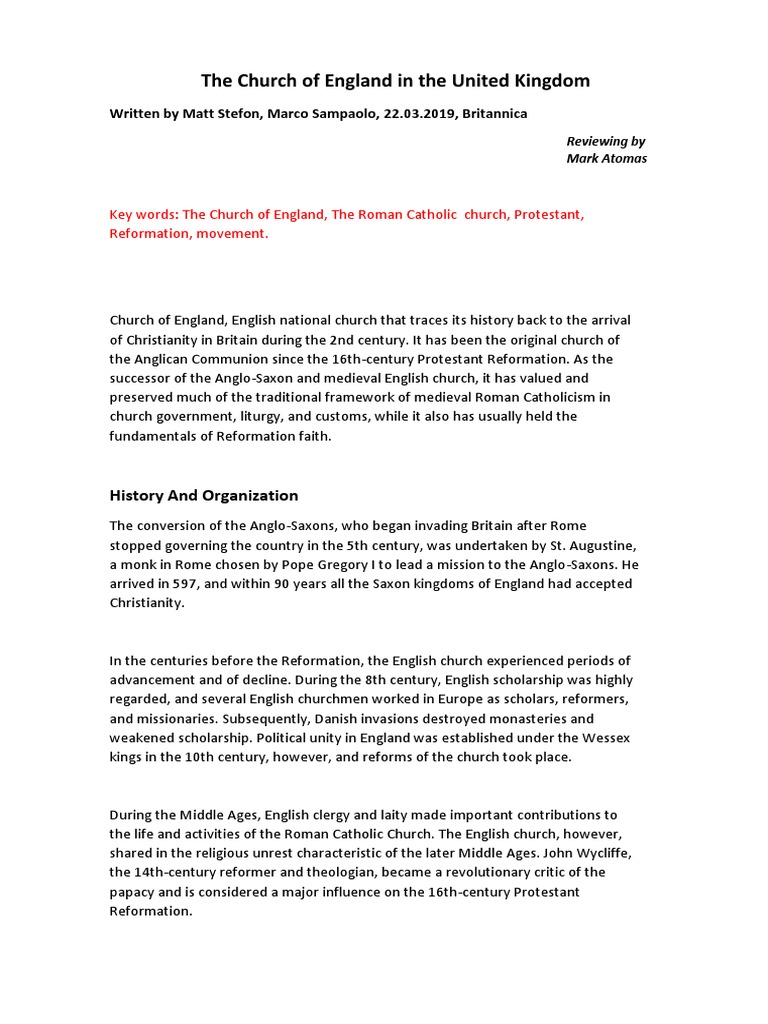The Anglican Church, often synonymous with the Church of England, serves as both a spiritual beacon and a historical narrative of a nation. The terms “Anglican” and “Church of England” are frequently interchanged, yet the complexities surrounding their relationship illuminate a fascinating evolution of belief and governance. This exploration invites us to delve into the rich tapestry of history that reveals how the Anglican Church emerged from the Church of England and how they interact today within a broader ecclesiastical framework.
To comprehend this relationship, one must first traverse the annals of history, particularly the seismic shifts that unfolded during the Reformation in the 16th century. King Henry VIII stands as a pivotal figure in this saga. His desire for an annulment from Catherine of Aragon, coupled with his desire to establish supremacy over religious matters within England, catalyzed the schism from the Roman Catholic Church. In 1534, the Act of Supremacy was enacted, declaring the monarch as the Supreme Head of the Church of England. Thus, what is often called the English Reformation set forth a monumental transformation in the landscape of Christian worship and ecclesiastical authority.
As a consequence of this break, the Church of England adopted certain Protestant principles while retaining vestiges of Catholic tradition, setting the stage for the establishment of Anglicanism. This approached became more pronounced during the reign of Edward VI, whose short tenure saw the introduction of the Book of Common Prayer and the Forty-Two Articles, documents that would shape Anglican liturgy and doctrine. It is essential to appreciate how these early structural changes laid a foundation for a unique identity that would evolve over centuries.
The subsequent reign of Mary I attempted to revert the Church of England to Catholicism, highlighting the ongoing tensions within the religious landscape. Following her death, Elizabeth I ascended to the throne and sought to establish a via media—a middle way—between Catholicism and Protestantism. The Elizabethan Religious Settlement of 1559 sought to create a more unified church that balanced various theological positions. This period crystallized the perception of Anglicanism as a distinct tradition rooted in the national identity of England while fostering deeper allegiances to the broader Catholic Church of Christ.
At the heart of Anglicanism lies the formulation of its doctrine, encapsulated in the Thirty-Nine Articles, which espouse a belief system that is characterized by both historical depth and theological breadth. These articles are crucial in understanding how the Church of England diverges and, at times, converges with other Christian denominations. The Anglican tradition particularly emphasizes Scripture, tradition, and reason as guiding principles, which not only define the faith but also nurture an environment conducive to diverse interpretations within its communion. This adaptability facilitates relevance across various cultural landscapes while maintaining theological integrity.
Furthermore, the Anglican Church extends beyond the ecclesiastical borders of England. The establishment of the Anglican Communion, a global family of churches, reflects the growth and dissemination of Anglicanism worldwide. With provinces in diverse nations, the Anglican Communion embodies a rich mosaic of cultural expressions of faith—each contributing to a broader understanding of what it means to be Anglican. This phenomenon illustrates that while the Church of England is the foundation of Anglicanism, it is far from its singular embodiment.
Modern-day Anglicanism grapples with contemporary issues that challenge its unity and identity. Debates around social justice, gender equality, and human sexuality have created rifts within the Anglican Communion, echoing a historical pattern of theological contention that dates back to its formation. The decision to ordain women as bishops and the acceptance of same-sex marriages in some provinces represent significant cultural shifts that mirror broader societal changes. The process by which these issues are addressed reveals the dynamic nature of Anglicanism—an essential perspective for understanding both its past and its future.
The essential question remains: Is the Anglican Church synonymous with the Church of England? While they are intricately linked, the relationship is not unequivocal. The Church of England retains its identity as a national church with established historical roots, whereas the Anglican Church evolves as a global entity reflecting the plurality of Christian belief. This duality provides depth to the understanding of Anglicanism, inviting adherents and scholars alike to engage with the nuances of both identity and practice.
Looking to the future, the Anglican Church must confront the challenges and opportunities that arise from its position in a rapidly changing world. The commitment to inclusivity, the preservation of liturgical traditions, and the reconciliation of the diverse beliefs within the Anglican Communion will be vital in maintaining its relevance. In this, the Anglican Church serves as a lens through which one may perceive the broader struggles that have always marked the Christian tradition—grappling with the implications of faith in a multifaceted world.
In conclusion, the historical evolution of the Anglican Church from its roots in the Church of England offers an insightful perspective on the nature of tradition, authority, and belief. It compels contemplation of how a church, emerging from turbulent beginnings, can shape a profound legacy that transcends geographical and theological boundaries. As the Church continues to navigate the complexities of modernity, understanding its past will remain necessary for a vibrant and faithful future.



